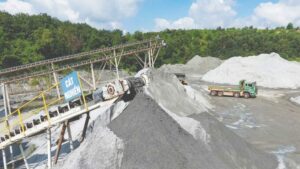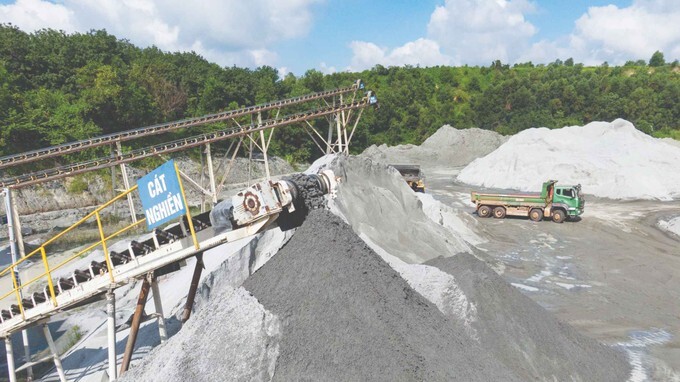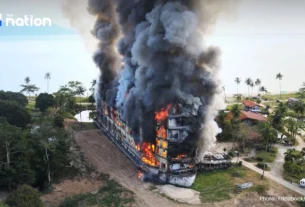 Sand shortage for Vietnam expressway construction projects addressed
Sand shortage for Vietnam expressway construction projects addressed
25 June 2024
Vietnam’s rapid infrastructure development, particularly in the Mekong Delta region, is facing a significant challenge a high demand for sand as backfill material for expressway construction projects.
Sand scarcity threatens to delay or even halt construction, jeopardizing project timelines and overall economic progress while under the government’s guidelines, many projects must be finished in 2025 and 2026.
According to the Minister of Transport, from 2021 to 2025, six major expressway construction projects have been underway in the Mekong Delta region and the South East region in Southern Vietnam. The demand for sand in the Mekong Delta is estimated to reach 70.6 million cubic meters, with 63 million cubic meters specifically required for backfilling. However, only 37.3 million cubic meters have been identified, leaving a deficit of 24.4 million cubic meters.
According to the capacity of licensed mines, the total volume of missing sand that needs to be brought to the construction site to ensure construction progress is 33.7 million cubic meters. Among them, localities have only had confirmation or allocated from commercial mines about 28.7 million cubic meters.
Deputy Minister of Transport Nguyen Danh Huy said that following the requirement of the National Assembly and the government, three key projects ought to be finished in 2025 including the Can Tho – Ca Mau section of the North-South Expressway, the Bien Hoa – Vung Tau Expressway, and the Ho Chi Minh City Ring Road 3. Projects that must be completed in 2026 are Chau Doc – Can Tho – Soc Trang and Cao Lanh – An Huu expressways. With the current supply situation of sand materials, the governing agencies have had to recalculate the construction progress and project completion time.
According to the latest update, only the Can Tho – Ca Mau component project and the Bien Hoa – Vung Tau Expressway project are expected to be completed by the end of 2025. The completion of the Ho Chi Minh City Ring Road 3 project has been delayed to 2026, and the Chau Doc – Can Tho – Soc Trang Expressway project has been delayed to 2027.
The shortage of sand for embankments is still a persistent problem at all expressway construction sites. According to a review by a task force of the Ministry of Natural Resources and Environment (MoNRE), An Giang Province plans to utilize sand from two dredging projects (about 2 million cubic meters) and supplement it from quarries in the planning area (about 2.5 million cubic meters).
Although Tien Giang Province still has reserves of about 41.8 million cubic meters, of which 21.9 million cubic meters have not been granted exploitation licenses and 19.9 million cubic meters have been granted licenses but have expired. In Vinh Long Province, two quarries have been granted certificates and completed procedures for exploitation since February 2024, but cannot be exploited due to obstruction by local residents while three quarries in Dong Thap Province are also currently suspended.
According to contractors, the process of completing sand mining procedures is very time-consuming, and the approval for increasing the capacity of quarries in localities is still slow, affecting the construction progress, especially for projects that need to be completed by the end of 2025. In the meantime, sea sand can only be exploited until the end of August 2024 (due to rough seas), and if it is not done immediately from the first week of June 2024, it will not be possible to exploit enough of the quantity as planned.
In this context, contractors and management agencies have considered importing sand from Cambodia, but the cost of imported sand is turning out a problem. According to Assoc. Prof. Le Trung Thanh, Director of the Department of Construction Materials under the Ministry of Construction, Cambodia has a very abundant supply of good quality sand that is suitable for construction projects. However, the import of good quality sand from Cambodia for expressway construction needs to be carefully considered, as the market price of sand can fluctuate, sometimes increasing by three times compared to the estimate.
This situation has prompted experts to continue proposing the option of building elevated bridges. According to the Ministry of Transport, the elevated bridge solution is about 2.6 times more expensive than the embankment solution, leading to a higher investment rate. However, General Director Nguyen Van Lam of Transport Construction Engineering Consultancy Company, believes that the construction cost of elevated bridges of roughly VND21.6 million per square meter is not much higher than the construction cost of road foundations on weak soil if they have to be treated with longitudinal box culverts and load-reducing slabs with the cost of about VND19 million per square meter. This neglected to mention the maintenance and repair costs of elevated bridges which are much lower than those of embanked roads.
With the same view, Vice President Tran Ba Viet of the Vietnam Concrete Association suggested that the current total investment in construction projects in Vietnam mainly considers direct costs and does not mention maintenance costs; thus, the choice of construction method will not be accurate, as the economic efficiency is not true to reality.
He added that many countries in the world have calculated the maintenance costs of construction projects over 50 years. In fact, many national highways and expressways in the Mekong Delta are undergoing extensive repairs, costing trillions of Vietnamese dong. This fails to mention the construction of elevated bridges which will have better flood escape capacity than embanked expressways.
The construction of elevated bridges poses a challenge to the availability of concrete materials in Vietnam. In response to this question, Mr. Tran Ba Viet said that for ultra-high performance concrete, sand from Cam Ranh beach in the South Central Province of Khanh Hoa and the Central Province of Quang Binh is already available in tens of millions of cubic meters. The source of binders is also available as Vietnam’s cement production reaches 100 million tons yearly, and is currently exporting 25-35 million tons a year. Reinforcing steel and prestressed steel cables also reach about 20 million tons a year, and are surplus for export.
Other materials such as fly ash, active blast furnace slag, and Silica fume are by-products of the thermal power and steel industries and are currently available in about 15 million tons a year. Chemical admixtures are all actively supplied by domestic companies. If the use of these materials is researched, expressway projects will no longer be heavily dependent on natural sand resources.
By Bich Quyen – Translated by Anh Quan
Source: https://en.sggp.org.vn/sand-shortage-for-expressway-construction-projects-addressed-post110755.html


